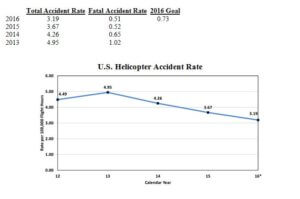The United States Helicopter Safety Team (USHST) has released its 2016 full year accident rate findings, which show accident rates for the U.S. civil helicopter industry were pushed downward as safety lifted upward during 2016. Preliminary data shows that the 2016 accident rate was 3.19 per 100,000 flight hours, compared to an accident rate in 2015 of 3.67.
This 13 percent decrease continues a downward trend in helicopter accidents since 2013, and maintains an improving safety record for the industry. The fatal accident rate remained statistically the same year-over-year, but was considerably lower than the 2016 goal set by USHST.

Comparing 2016 with 2013 (when the USHST industry-government partnership was created), total civil helicopter accidents have decreased by 27 percent and fatal accidents have been cut by 43 percent.

Reducing fatal accidents even further is a central USHST aim. From 2016 through 2019, the USHST is focusing major attention on reducing fatal accidents within the U.S. civil helicopter community. The industry-government partnership is targeting a reduction by 2019 to 0.61 fatal accidents per 100,000 flight hours. The fatal accident rate goal for 2016 was 0.73 or lower, and for 2017, it is 0.69.
Data for 2016 is preliminary and there is potential for at least two more adjustments to the annual rates.
In March 2017, the Federal Aviation Administration’s (FAA’s) next Aerospace Forecast will be released and an adjustment could be made if the estimated 2016 flight hours shown in the 2017 forecast are different than the 2016 forecast. A final adjustment could occur after September 2017 when the FAA’s 2016 General Aviation and Part 135 Activity Survey publishes data based on rotorcraft flight hours received from operators. It should be noted that in recent years, the FAA forecast of U.S. rotorcraft flight hours has been within two to three percent of the flight hours published in the annual GA and Part 135 Survey, so adjustments to the rates are anticipated to be minimal.









